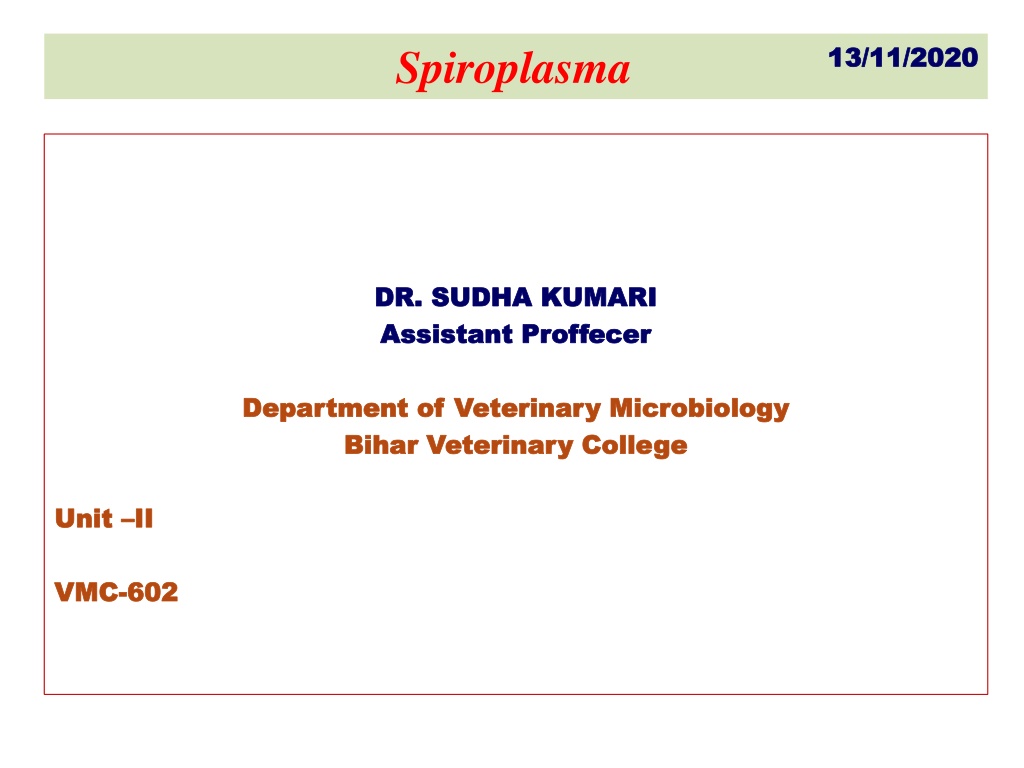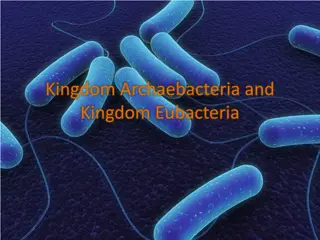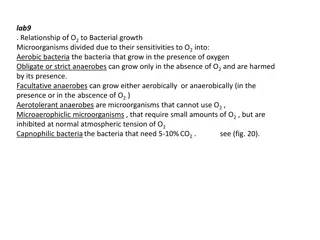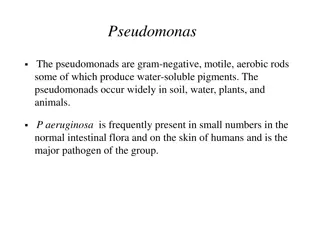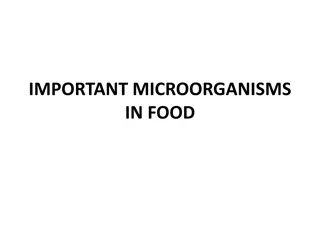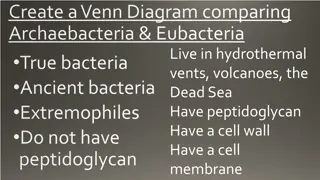Understanding Spiroplasma: Tiny Bacteria Without Cell Walls
Spiroplasma is a genus of Mollicutes characterized by their helical morphology and lack of cell walls. They are commonly found in insects and plants, with some species causing diseases like citrus stubborn disease and corn stunt disease. Spiroplasmas are fastidious organisms that require specific growth conditions and are known for their unique properties as endosymbionts and disease-causing agents. Despite their small size, they play significant roles in various ecosystems.
Download Presentation

Please find below an Image/Link to download the presentation.
The content on the website is provided AS IS for your information and personal use only. It may not be sold, licensed, or shared on other websites without obtaining consent from the author. Download presentation by click this link. If you encounter any issues during the download, it is possible that the publisher has removed the file from their server.
E N D
Presentation Transcript
13/11/2020 13/11/2020 Spiroplasma DR. SUDHA KUMARI DR. SUDHA KUMARI Assistant Proffecer Assistant Proffecer Department of Veterinary Microbiology Department of Veterinary Microbiology Bihar Veterinary College Bihar Veterinary College Unit Unit II II VMC VMC- -602 602
The bacteria are common in haematophagous arthropods: deerflies, horseflies, mosquitoes, and in ticks, where they may occur abundantly in salivary glands. The ability of spiroplasmas to propagate in rodents was experimentally proven, and Spiroplasma infections have been reported recently in humans. Some authors have purported an etiological role of Spiroplasma in causing transmissible spongiform encephalopathies (TSEs), but convincing proof is lacking.
Spiroplasma Spiroplasma is a genus of Mollicutes, a group of small bacteria without cell walls. Spiroplasma shares the simple metabolism, parasitic lifestyle, fried- egg colony morphology and small genome of other Mollicutes, but has a distinctive helical morphology, unlike Mycoplasma. The name mollicutes soft skin reflects the major collective characteristic of these bacteria the lack of a cell wall which at the same time distinguishes them from all other bacteria with the exception of the chlamydiae. The lack of a cell wall is caused by the absence of genes encoding enzymes for peptidoglycan biosynthesis.
It has a spiral shape and moves in a corkscrew motion. Many Spiroplasma are found either in the gut or haemolymph of insects where they can act to manipulate host reproduction, or defend the host as endosymbionts. Spiroplasma are also disease-causing agents in the phloem of plants. Spiroplasmas are fastidious organisms, which require a rich culture medium. Typically they grow well at 30 C, but not at 37 C. A few species, notably Spiroplasma mirum, grow well at 37 C (human body temperature), and cause cataracts and neurological damage in suckling mice.
The best studied species of spiroplasmas are Spiroplasma poulsonii, a reproductive manipulator and defensive insect symbiont, Spiroplasma citri, the causative agent of citrus stubborn disease, and Spiroplasma kunkelii, the causative agent of corn stunt disease. The lack of a cell wall is closely linked to another characteristic feature of the mollicutes their cells are usually pleomorphic. Again, there is no rule without exception: the cells of the genus Spiroplasma have a helical shape.
Spiroplasma floricola Culture Spiroplasma floricola is grown at 34 C with the pH kept constant at 7.5 by automatic titration, in HEPES-buffered DSM 4 medium which contains, per 100 ml, 1.5 g PPLO broth base (Difco, Detroit, MI), 8 g sucrose (Merck, Darmstadt, Germany), 2.5 mg phenol red (Merck), 1.32 g HEPES (Merck), 500 mg glucose, and 10 ml of inactivated (30 minutes, 56 C) horse serum [ICN (Flow) Costa Mesa, CA]. Shape and motility of the spiroplasmas are regularly monitored by dark-field microscopy (1250 ). Spiroplasma species are mainly transmitted to plants by specific insect vectors; in order to achieve the transmission, they must cross the salivary gland barrier . S. citri and S. kunkelii invade the hemocoel through the gut epithelium of the insect host by a process of receptor-mediated cell endocytosis.
The genus Spiroplasma has arthropods as a peculiar host. Spiroplasma species (spiroplasmas) have developed different types of symbiosis with insects and mites, and, as recently shown, with crustaceans.
